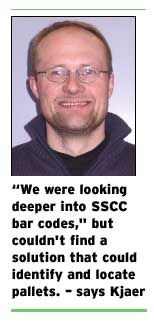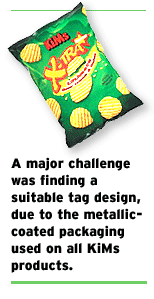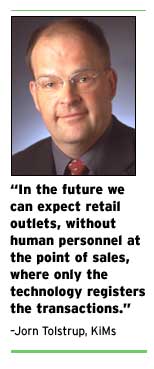May 31, 2004KiMs is one of the largest snack-food companies in Denmark. A midsize company with 270 employees and annual revenue of about $67 million, KiMs delivers snacks and potato chips to many retailers in Denmark, where unit sales of its snacks bought by consumers accounts for 51.3 percent of the nation’s snack-food market. Its product line includes 9 of the 10 best-selling chips in Denmark, and its brand is considered one of the five strongest in the country.
But with competition increasing from other snack-food makers, KiMs believed it needed to increase efficiency of its business processes—internally and externally toward its supply chain partners—in order to retain its position in the market. KiMs sharpened its competitive edge by RFID-enabling its shipping process. As a result, the company not only increased sales of its snacks, it also reduced the risk of shrinkage, trimmed inventory levels at its distribution center and cut labor costs.
KiMs’s quest for improvement began in early 2003, when the company’s management realized it needed better control of its downstream supply chain. The company was supplying 100,000 pallets of its snacks per year to its business customers, namely, the retailers. Frude Lausersen, a third-party logistics partner, transported 70,000 of these pallets; KiMs used its own logistics operation to deliver the remaining 30,000 pallets. The problem was, KiMs had no dependable system in place that would tell it exactly what time specific pallets left its manufacturing house and at what time they arrived at their respective destinations—third-party warehouses and retailers. The inability to accurately track products increased the risk for shrinkage, because KiMs had no way to determine if products were lost in transit. Consequently, the data on the retailer inventory levels was inaccurate, which left KiMs unable to effectively plan its procurement and production processes and fulfill retailer orders in a timely fashion.
A big reason why KiMs’s product information was so unreliable was that the company was using a manual process. To keep tabs on deliveries, KiMs depended on written lists that indicated the number of pallets that left its manufacturing site to go to the third-party warehouses or retailer locations. The company also relied on manually written lists of its procurements, products and sales orders to estimate its own inventory levels. The data was entered manually into KiMs’s ERP-system, which was developed in-house by its own programmers. Due to human error when entering data, the resulting product location and inventory information was of poor quality.
In an attempt to rectify the problem, KiMs implemented a bar code system. In the area where boxes of snack foods were loaded on wooden pallets, KiMs applied a bar-coded label to each completed pallet. Forklift drivers used a handheld scanner from Symbol to record each label’s bar code before moving the pallets to the staging area. At the staging area, truck drivers scanned the pallets before transporting them to retailers or a third-party logistics warehouse. The bar codes carried information about the products on the pallets. Once the labels were scanned, the data was sent automatically to KiMs’s enterprise resource planning (ERP) application.
occasionally had difficulty finding a pallet’s bar code label, and when they did find it, their handheld bar code scanners worked only if the label was no more 750 mm away. Even when drivers successfully recorded a pallet’s bar code, the extra time needed to scan labels resulted in increased salary costs.
To fix these shortcomings, Jens Kjaer, logistics manager at KiMs, and his team searched for a way to improve the bar code system. “We were looking deeper into the EAN-UPC standard SSCC [Serial Shipment Container Code] bar codes in order to find an optimal solution for the lack of product control management,” says Kjaer. But the company had trouble finding a bar code solution that could identify and locate each pallet in the delivery process, given that bar codes need to be scanned manually and required a line of sight between scanner and label.
While seeking a solution to these challenges, KiMs also looked at upgrading its IT systems in order to provide the company with better access to operational data, not only within the organization but also within its supply chain. After conferring with its supply chain partners, KiMs decided that Microsoft’s Axapta ERP application would give the company a better handle on manufacturing, raw-materials procurement, sales order management and warehouse management. Aston Business Solutions, which is the sales partner of Microsoft Business Solutions, was chosen to implement the ERP system.
Coincidentally, Microsoft Business Solutions had been working on launching an RFID-based Axapta system, and it was seeking an innovative, visionary and midsize company to test it. Aston Business Solutions suggested KiMs as a potential candidate that met that criteria and, moreover, was facing challenges that RFID would help overcome.
Microsoft and KiMs met in September 2003, and both parties soon agreed to run a test of the RFID-based Axapta system. KiMs was interested in testing a technology, such as RFID, that would enable the automatic identification of the products and not require human involvement to read data.
Three months later, the roll out of the RFID system began. Marc Kamstrup Jepsen, the lead program manager for Microsoft Business Solutions Denmark, and Bjarne Schon, its director of supply chain solutions, worked with Jens Kjaer, KiMs’s logistics manager, and Jesper Toubol, KiMs’s IT manager, to analyze the context in which the RFID-enabled Axapta was going to be tested. The team decided that scope of the project was to tag the products on pallet level for the Danish market, which is 70 percent of KiMs’s total production, and to use KiMs’s warehouse at its corporate headquarters in Sonderso as the trial site.
The implementation process also involved close collaboration between SAMSys, which supplied the RFID readers for the project. SAMSys participated in the evaluation of KiMs’s production cycle and bar code system, and consequently designed and supervised the installation of MP9320 long-range UHF (868 MHz) readers. Avery Dennison supplied the antennas for the tags, while Phillips Semiconductors delivered HSL rewriteable chips that could hold 2 kilobytes of data. (Microsoft Business Solutions wanted to test a more complex RFID application instead of a comparatively simple read-only one.) The plan was to apply a tag to the top carton stacked on a pallet and then write a unique identifier consisting of a serial shipping container code to the tag, thereby associating the pallet with comprehensive production data. The RFID system would read the tags during storage, loading and shipment, and the data would be fed back into Axapta.
A major challenge was finding a suitable tag design for the application, due to the metallic-coated packaging used on all KiMs products. In the initial trials, the packaging reflected RF signals, making it hard to accurately read and write to the tags. Although it took some time for the project team to find the right RFID tag, they finally settled on a solution by Avery Dennison that used the metallic coating of the chips' packaging as an element of the tag design. By using the metallic coating within the packaging to enhance the read range of a passive tag, the design of the tag could be kept simple, keeping the cost down.
For the KiMs deployment, RFID readers were installed at the pallet area and at the entrance and exit of the staging area. The RFID-enabled Axapta system also included Microsoft's demand-planning software for sales forecasting; event-management templates for monitoring processes, such as purchase-order confirmations and supplier-delivery reminders; and Microsoft Business Network software and hosted services, a transaction network that lets KiMs exchange business documents electronically with its suppliers and distributors. Implementation of the RFID technology enabled data and information sharing in the supply chain, letting KiMs’s retailer customers get more involved in the delivery process and enabling more control and visibility.
KiMs’s Kjaer says that the RFID project ran smoothly overall and the vendors worked hard to deliver optimal results. Because the RFID system ran simultaneously with the existing bar code system, the project did not disturb the daily routines at KiMs site. Marc Kamstrup Jepsen, lead program manager at Microsoft Business Solution, says that running both technologies at the same time provided the best change-management process. It gave KiMs management the opportunity to turn off the bar code component in the Axapta system and run the system solely using RFID when it was ready to do so.
their own RFID systems, the tags are not being reused, leading to a loss of the tags once the pallets reach the retailers. But this situation could be corrected, says Schon, by involving the supply chain partners so they can also benefit from the tagging of pallets.
KiMs’s Kjaer says that a major benefit of the RFID system is the real-time information management it provides. Although KiMs still cannot quantify that value five months after the pilot’s roll out, the improved visibility in the supply chain has reduced the risk of shrinkage and enabled the tracking and tracing of the products in the delivery process. Another advantage of the RFID tags is the trimming of inventory levels at the distribution center due to increased data accuracy, improving the quality of operations, reducing out-of-stocks in retail stores and cutting labor costs related to shipping and record-keeping. With more accurate information on inventory and shipping, KiMs can better plan its production and related processes, which facilitates better service to its retailer customers. Not only can KiMs fulfill sales orders on time due to accurate knowledge of its inventory, the company has also improved its demand forecasting by having access to information about which products are being sold most to which retailers in a certain geographical area.
At a strategic level, Jorn Tolstrup, CEO at KiMs, sees many benefits of having initiated an RFID implementation at a time when large Danish retailers are still looking at the RFID technology. He believes that being an early adopter of RFID has given KiMs a competitive advantage.
“We are the leading manufacturer of chips and snacks and in growth at the export market,” Tolstrup says. “We have achieved that position by being good at predicting future customer and market demands. Therefore, it is important for us to be aware of the latest technologies. In the future we can expect retail outlets without human personnel at the point of sales, where only RFID technology registers the transactions. Only by adopting the technology now can we evaluate the benefits and limitations of RFID technology for future use. KiMs is taking a step into the future supply chain management by having applied RFID to its existing supply chain applications.”
Farhat Khan is a Danish freelance writer.





